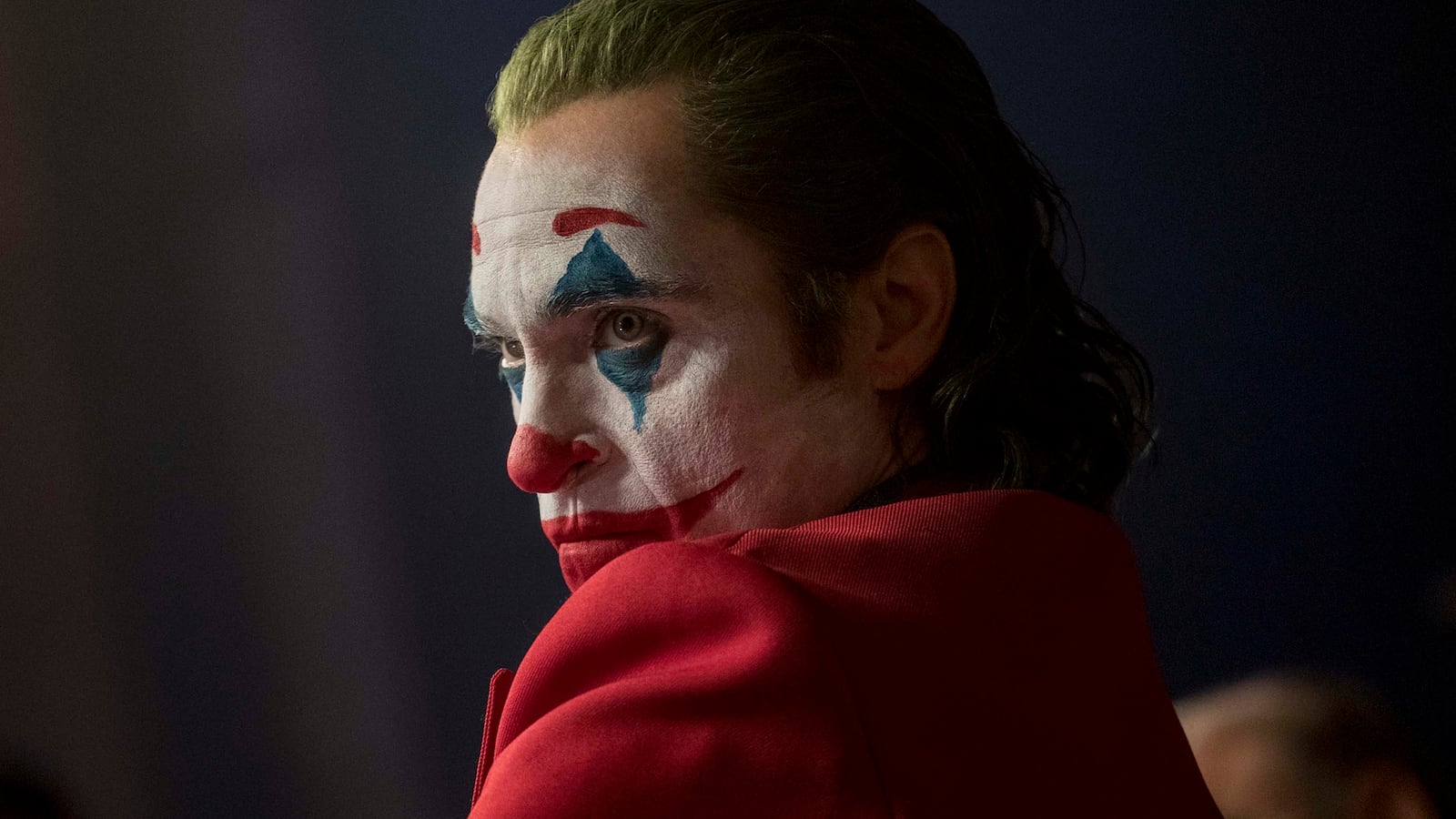Note: The following article contains spoilers for the plot of Joker.
Joker is a fine movie—neither terrible nor great, though graced with a showstopping, occasionally transcendent performance at the center of a thematically muddled story. It envisions an origin for the Joker, Batman’s arch-nemesis, itself a creatively risky endeavor. The menace of the Joker, at least in recent screen iterations and in the last few decades of comic books, stems in crucial part from how impossible it is to make sense of him, a force of random, meaningless chaos and violence who delights in inducing despair at the “pointless” farce of our society. Defining who he was before the green hair and purple suit—giving him a name, an occupation—risks diluting some of the character’s potency.
It’s canny then of director Todd Phillips and co-writer Scott Silver to offer not just an origin story, but a cautionary tale meant to speak to the absurdity of our times. Joker gropes at ideas about mental illness, class conflict and our worship of violence, aiming to be Taxi Driver by way of the DC Universe. But where Taxi Driver—and Joker’s other obvious Scorsese influence, The King of Comedy—indict the cultural impulses that drive such violence and fetishize its perpetrators, Joker can’t quite bring itself to say anything so pointed, let alone political. It settles for being a pastiche of the anti-hero films of yesteryear with a fraction of the bite.
If this were another story with another premise, pastiche might be fine enough; Stranger Things does it with ’80s genre movies. And some of the best superhero movies of the last decade have elevated their game by mimicking the styles, themes and imagery of older, all-timer films. (Captain America: The Winter Soldier echoes ’70s conspiracy thrillers; Logan is indebted to Shane.) But without a coherent point of view about the world around him, Joker can’t illuminate much about its sad clown’s descent into madness or, more specifically, why he chooses to embrace violence rather than recoil from it. In avoiding politicization, it lands on a simplistic half-answer instead: he just couldn’t help it, OK?
Rather than a revelation, the film’s denouement is an IP-driven, reverse-engineered inevitability. We see this joker become the Joker because this is a movie called Joker. If that was the goal, why invoke Scorsese at all, beyond assuming the appearance of prestige? Why does this individual, out of all the bullied, mentally-ill people in Gotham, break so breathtakingly bad?
In Phillips’ telling, the man who goes on to become the Clown Prince of Crime was once a sweet, if off-puttingly strange aspiring stand-up comic named Arthur Fleck. He’s the sort of wretch most people might avoid eye contact with: troubled, lonely, with an air of vague unpredictability, in part because of a “condition” which causes him to erupt into raucous, uncontrollable howls of laughter, even when he is stressed, sad, or anxious. (Indeed, the laughter often seems triggered by bad feelings.) Phoenix elicits both pity and revulsion through his laughter; his voice, so often tender when speaking, contorts to a horrific blend of pain, shame, and fear as he chokes on the sound still booming out of his body. His eyes well up as he folds himself over, as if making himself smaller might contain it. It’s a phenomenally unsettling performance.
Arthur is only thinly defined at the start of the film beyond his own miseries and the (sometimes real, sometimes perceived) cruelty of others: the inattention of his overworked, state-appointed therapist; the beating he suffers at the hands of adolescent punks while working as a clown-for-hire, twirling a sign outside a store. The script includes moments of sickly-sweet irony meant to add an uncomfortably juvenile shade to middle-aged Arthur, as when he introduces himself at an open mic by relaying how his mother always tells him he was “born to bring joy and laughter into the world.” Still, Phoenix makes Arthur feel human more effectively when he expresses sincerity and a fragile sense of hope through, for example, the delicate spring in his step as he dances and twirls that sign. Those moments, though few and far between, are why we feel for Arthur as he’s abused, ignored, and humiliated again and again.
The Gotham City Arthur lives in is an exquisite approximation of the grimy, tension-wracked New York City of the late ’70s and early 1980s, as captured in Taxi Driver, King of Comedy, Midnight Cowboy, and more of the era’s defining New York films. Out-of-touch billionaire Thomas Wayne is running for mayor, while class resentments are running close to a boiling point. Budget cuts put Arthur’s therapist out of work, and he’s left without access to medications. “Super rats,” meanwhile, are invading the city after a garbage strike has left trash bags piling high in the streets—literalizing the “filth” that Taxi Driver antihero Travis Bickle was so obsessed with eradicating.
It’s in this time of austerity that Arthur first tastes the perverse sense of power and control that can come with violence. Three white, drunk, and inexplicably Broadway-literate finance bros corner Arthur on a train, taunting him with a lengthy rendition of Stephen Sondheim’s “Send in the Clowns.” They beat him mercilessly until Arthur, suddenly remembering the gun another clown-for-hire gave him for “protection” (his real intentions were less charitable), fires a round straight through a guy’s face. Something in Arthur snaps. Not satisfied with one murder, he stalks one after another until all three of his tormentors are dead.
Far from a rush-of-the-moment act of adrenalized rage, however, Arthur’s subway slayings become just the first in a series of increasingly violent, deranged killings. He suffocates his own mother, about whom he’s just uncovered a traumatic lie. He slices and repeatedly smashes in the skull of the colleague who set him up. Finally, he shoots the late-night talk show host he worships, Murray Franklin (played by Robert De Niro, in a reversal of his role as the fame-obsessed aspiring comedian who kidnaps a late-night host in King of Comedy), on live television, as retribution for turning Arthur into a nationwide laughingstock. And he feels nothing about any of it.
In real life, an abused, mentally ill person going off their meds doesn’t necessarily mean they will become rampaging murderers. Why it happens to Arthur, one might think, merits some examination. There’s none. We’re left only with Arthur’s own solipsistic, guilt-dodging catchphrase, delivered to his last victim: “You get what you deserve.”
Arthur’s murders play out amid radio and TV reports of a so-called “anti-rich” movement swelling in the city. Income inequality protesters, after learning that an anonymous man dressed as a clown shot three young bankers dead, soon seize Arthur’s story as a symbolic triumph, donning clown masks, cheering the murders, and wreaking havoc around Gotham. Phillips & Co. seem to want to draw parallels between this city-wide crowd of lunatics (again: they are cheering on actual murder) and real-life protesters, down to the poster board signs bearing slogans like “Resist.” Sorry, who are the bloodthirsty losers here? Left-wingers? The poor? The public at large? The film doesn’t dare parse the matter thoroughly enough to pin its condemnation on anyone.
Even Wayne, a stand-in for the wealthy elitists who stood by as Gotham languished (and cut its social services funding), is depicted as a victim in his final moments, helplessly shielding his wife and young son from a mugger in an alleyway. Is he the problem, then, or a casualty of it? (One answer might have been that neglecting the poor and mentally ill harms every sector of society, but the film never tries to articulate that.) What is the film saying about class and inequality? And what does it mean that, at the height of his murder-driven glee, embraced by thousands on the streets, there still isn’t a soul alive who truly cares for Arthur?
The film so often gestures at grandiose messaging, as if revealing hard truths about our society, while in fact saying nothing new or interesting at all. This year has brought better movies about class (Hustlers, for one) and more are still to come (Parasite is out in the U.S. next week). But Joker still feels like a missed opportunity. The Clown Prince of Crime himself might believe in nothing; that’s never meant that stories about him should be equally vacuous, too.







